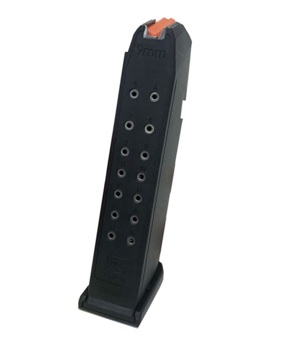Double-stack Glock 17 mags are about as simplistic as firearm magazines come. It’s basically a body, a base plate, an insert, a spring, and a follower.
But, all too many people keep their guns squeaky clean while turning an abjectly blind eye to the magazines.
Over time, fouling, dust, dirt, and even corrosion can work their anti-magic on your mags, preventing them from feeding smoothly, or from feeding at all.
Here’s how to avoid that with some regular Glock 17 mag maintenance.
Inspect Regularly
Identifying the fact that your Glock’s mag needs to be cleaned is the first step in sidestepping any potential issues.
Just give it a good, quick look. Is the follower clean, or can you see that there’s dust and fouling all gummed up around the top of the follower under the feed lips?
This, and fouling or dirt caking the sides of the mag tube itself are your first signs that you need to take the thing apart and clean it.
On that note…
Don’t Attempt a Deep Cleaning Without Disassembling the Mag
If and when you do notice you need to clean your Glock’s mag (when, really, because if you shoot enough it will become necessary) don’t try to give it a cursory cleaning and then be done with it.
It’s worth it to take the thing apart and clean it the right way.
Using a pin punch or a screwdriver, depress the spring-loaded pin through the hole in the bottom of the base plate, and slide the base plate forward.
Before removing it entirely, cup the bottom of the mag with your hand to prevent the insert, spring, and follower from shooting out.
Then, remove the insert (floor plate) spring, and follower.
Clean each of these separately and dry them thoroughly before reassembling them in reverse order.
It might surprise you how much fouling gets trapped down inside the mag body through the course of a few shooting sessions, so don’t neglect a good cleaning.
Consider Getting a Speed Loader
Glock 17 mags, unlike many other mags on the market today, are typically made of polymer - just like much of the rest of the Glock.
This polymer is very strong, very lightweight, and impervious to corrosion, unlike steel, but it also isn’t as strong as steel or aluminum.
Consequently, if you’re not careful when loading your mags, it’s possible to damage the feed lips, and distorted or damaged feed lips will hinder fluid feeding.
There are two workarounds to this. One is to take your time when loading, and the other is to use a speed loader, as speed loaders can load loose rounds quickly and efficiently without damaging a mag’s feed lips.
Also, there are 9mm speed loaders readily available at most sporting goods shops and gun shops for just a couple of dollars - it’s usually worth the small investment to put time back into your range schedule and preserve your Glock magazines.
Avoid the Use of Solvents Where Possible
Solvents, like Hoppe’s No. 9, are generally acceptable to use on steel and aluminum magazines because the solvent won’t damage these metals.
However, solvents like these can be potentially deleterious to the polymer bodies of some other magazines, like those that come with Glock pistols.
Also, you generally do not need it. Save the solvent for the bore and slide which are going to receive the lion’s share of fouling.
As for the magazine? A little warm water and soap are really all you should need to clean things up.
Don’t Over-Oil
Let us be clear on this recommendation. You don’t need to oil your mags to lubricate them. This is especially true of polymer mags, some of which are capable of self-lubrication.
The reason you might want to use oil - and only a little of it - is to protect the spring against corrosion.
If you do apply oil, use an oil like Rem Oil or Hoppe’s Lubricating Oil and apply it only to the exposed metal parts of the mag, like the spring.
Use only a very little, to seal the spring off from atmospheric moisture, thereby preventing corrosion. Less is more, as oil attracts dust and fouling and can accelerate abrasive damage even though it protects against corrosion.
As for the polymer parts, use no oil. It’s not needed, as polymer does not rust, and all it will do is attract particulate debris.
Perform a Functionality Check with Snap Caps After Reassembling
The last bit of advice we have is this. After you take your Glock 17 mags apart for deep cleaning and put them back together, perform a functionality check while you’re still at the bench.
You don’t want to get to the range only to discover you botched reassembly and the mag won’t function.
Load a few snap caps and cycle them manually. If the mag feeds, you are good to go.

Need New Glock 17 Mags?
Need a few more Glock 17 mags to add to your range bag? Are your old mags a bit too worse for wear?
We have what you need - and ammo. Stock up here and save before your next trip to the range.

